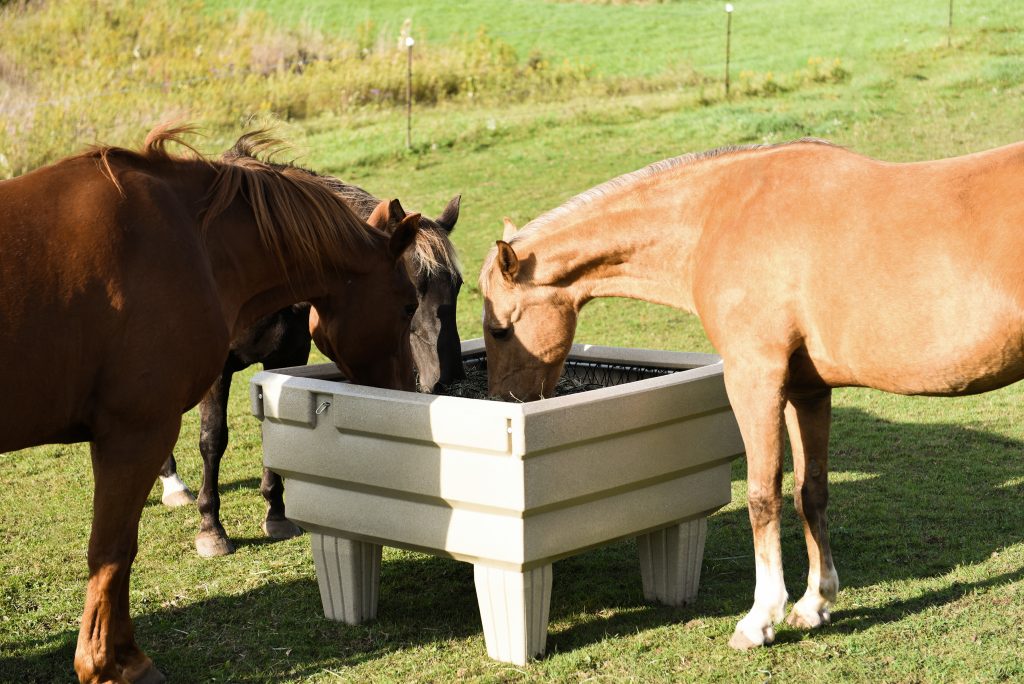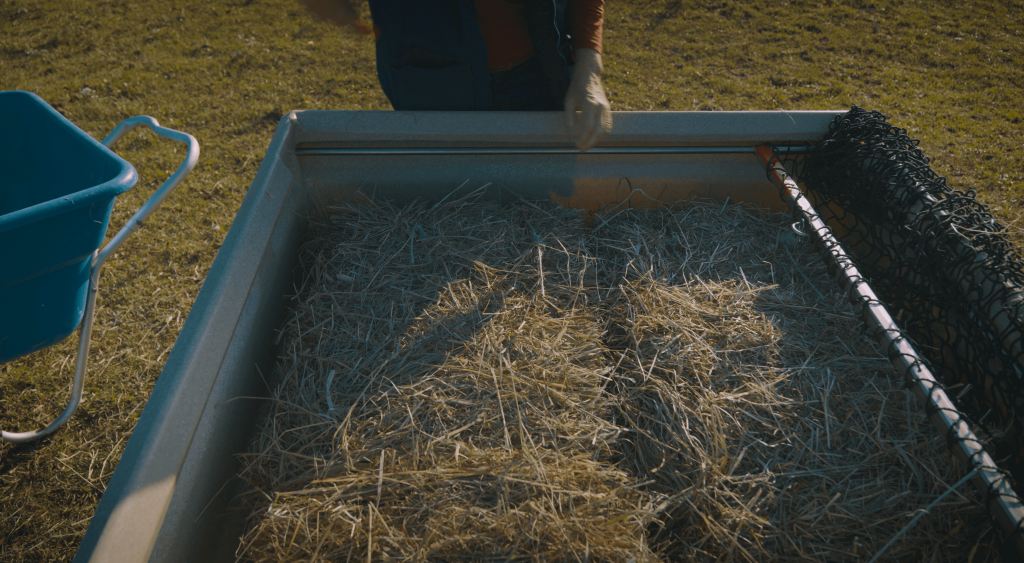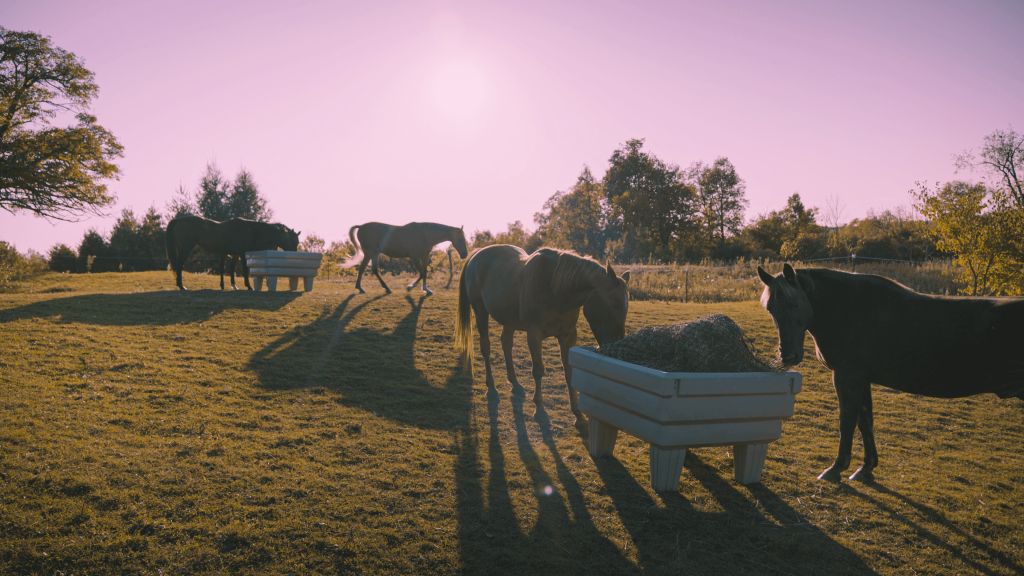Debbie Disbrow shares her thoughts on a better feeding solution for your horses.
While the barn is a place to come together with your horses to feed, clean, and socialize, the pasture is truly the horses ‘center’. This is where they live and more importantly, graze. Horses are grazing animals. From their wild instincts, foraging throughout the day is best for a horse’s digestive system. Having the ability to choose when to eat is most natural to them.
I personally have ten horses that we care for and find myself making the same decisions that other horse owners do. My horses are in the pasture most of the time grazing on grass, but like most horse owners, I also supplement with hay. When I feed them, they like to eat their ration of hay….but eventually look for more. Especially when my herd of six larger horses eat together, you can see the defined pecking order as the boss horse leaves his area to go to the next horse’s hay in line. Then, the next horse in line moves on to the next…and well, you get the idea.

A few years ago I decided to try round bales. The price of hay was very high due to a wet, soggy spring. Round bales were a little lower in price and I knew my horses could feed on a round bale for a number of days. I started by purchasing a round bale feeder and a spike for my tractor to move the round bales. The round bale worked well at first. However, as time went on, the weather and a free-for-all feeding bar was not working out as well as I had hoped. My horses were loading up on hay and it didn’t take long for them to gain a bit of weight. So we decided to put the round bale in an attached riding area to the pasture. Then, we were turning horses in and out of the food bar. This was becoming more than I bargained for.
Next, add in the weather. During the nice weather, the round bale was not too bad. With that being said, add some rain, snow, or sleet, and the round bale was looking pretty sad. I questioned my horses eating the wet hay. Over time the round bale feeder needed to be moved. The wet hay that was being pulled out of the round bale feeder was now being wasted by dropping to the ground. This resulted in the hay getting stepped on and pushed into the dirt. My idea of saving money was not panning out. I was losing a lot of costly hay and my horses were getting hay bellies. Uggghhhh…..

We started to look at the slow hay feeders on the market. They made more sense and I felt that spreading the feeding time out was more natural because it replicated the grazing that horses need. Studies show that horses spend up to 16 hours grazing a day. Therefore, it is important that they are free to follow their natural instincts for their overall health. I also thought about the many horse owners that we talk with. Many cannot have large pastures or their horses are on dirt lots. As a horse owner, it concerned me to think that so many horses were not able to graze. Small dry lots tend to have more abuse and are not suitable for electric fence. Horses tend to put a lot of wear and tear on fences when they lean on rails to reach grass outside of the paddock. With all of this in mind, I knew there had to be a solution to our problem.
As with all of our products for horse owners at RAMM, we seek out what we would want to use for our own horses. After researching slow feeders, I want to share the information my team found with you. I feel we have found the benefits needed in OptiMizer Feeders. They are made of durable and lightweight Linear Low-Density Polyethylene (LLDPE). This is the same material that playground equipment and drinking water tanks are made from, with a stainless steel assembly mounted inside. This helps make them tough and strong. All corners are rounded with 1″ diameters, making a smooth and safe surface if rubbed against. This is a much better option over metal slow feeders. The Hay OptiMizer is also simple to use and fast to load. Two bales of hay can be loaded in less than a minute. Unlike feeding directly on the ground, by using the OptiMizer you will save up to 50% of hay (my biggest problem solved)!

The slide arm for the net opens smoothly and easily. The feeder net hangs freely inside and conforms with the hay right to the bottom of the feeder. The tiniest bits of hay are always the tastiest! With this feeder, these delicate leaves aren’t lost to the ground but remain within the manger. There are twelve drainage holes at the base allowing any rain or dampness to drain. This is so much better than a round bale that sits in the rain, which can lead to mold.
The Hay OptiMizer has provided me peace of mind knowing that my horses always have hay. I also have a clean lot – no walked down, wet hay areas. Horses quickly learn how to eat hay from the OptiMizer. It mimics natural grazing. The horses eat slowly. They select, nibble, and chew their hay—just like they would be eating in the pasture. The OptiMizer is even a great choice for minis, as the legs can be adjusted. In conclusion, the OptiMizer is better for the horse’s health, which is most important. It helps with wear and tear to your fence systems or any other structure etc., in the paddock. The OptiMizer is also more cost-effective than round bales or ground feeding. My horses are happier and healthier by being fed more naturally.
Always have hay available for your horses, naturally.
The OptiMizer holds two bales of hay, up to 42″ long and 16″ square each or up to 150 pounds of flakes of hay from large square or round bales. The netting is made out of 100% raschel knotless nylon. Ltd. Lifetime warranty on plastic manger and stainless stell hay net assembly when used under normal and intended conditions.



